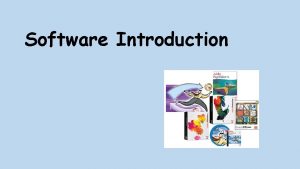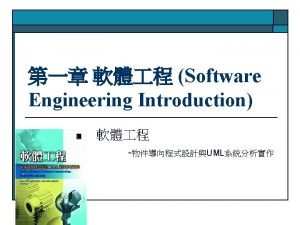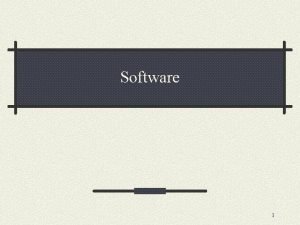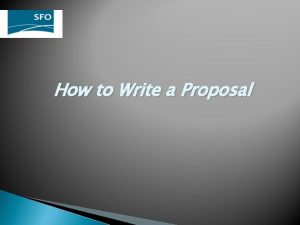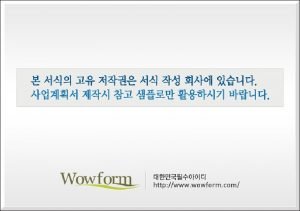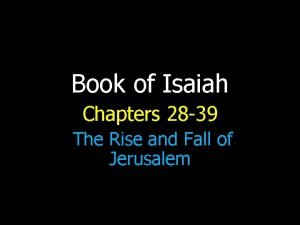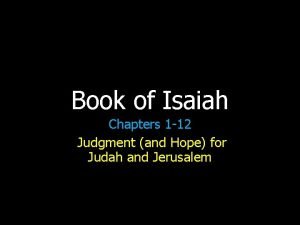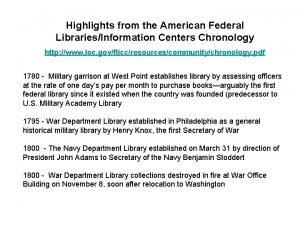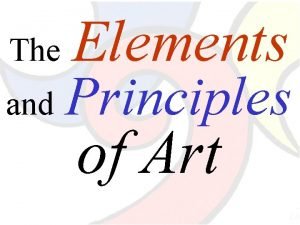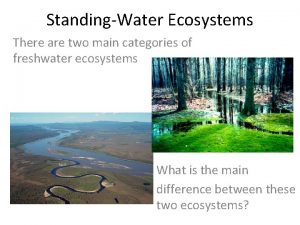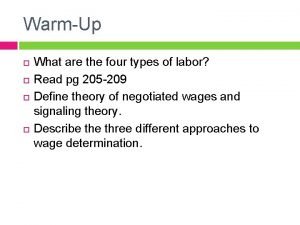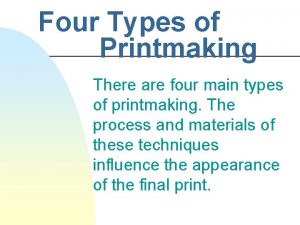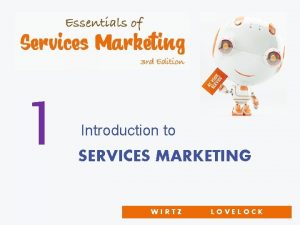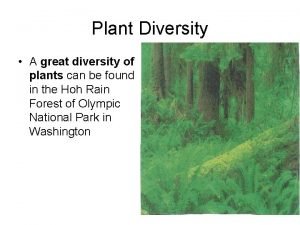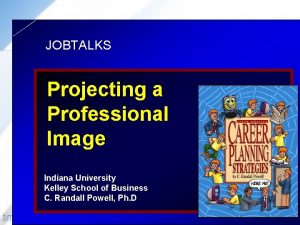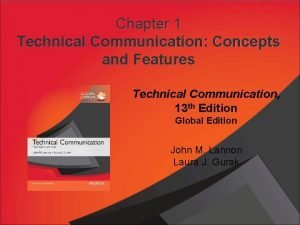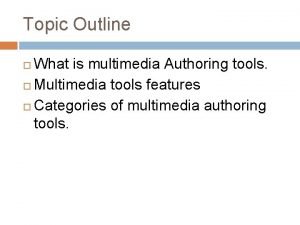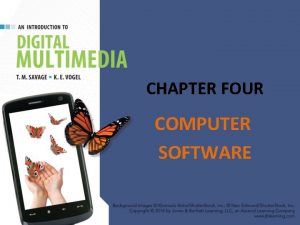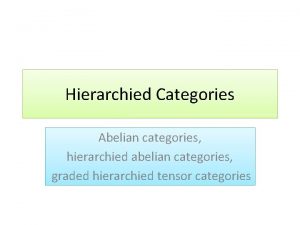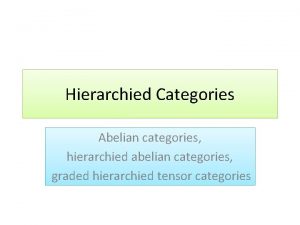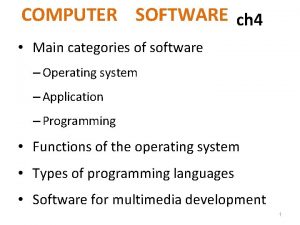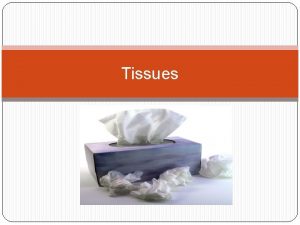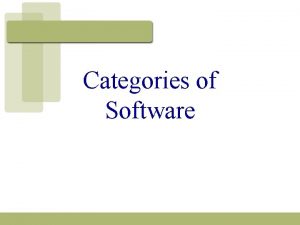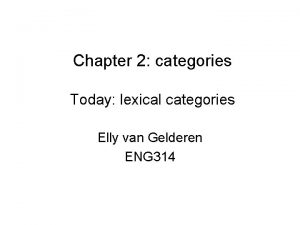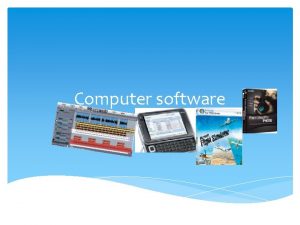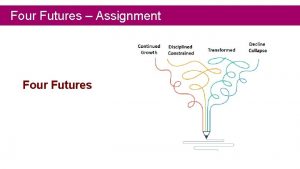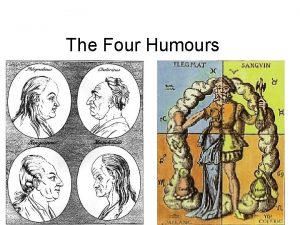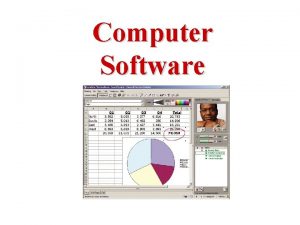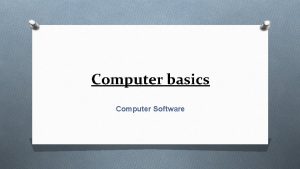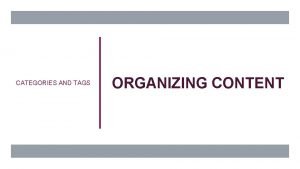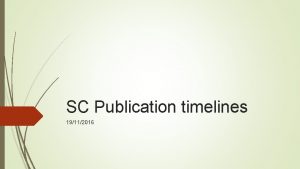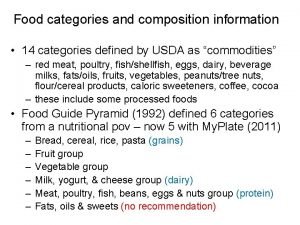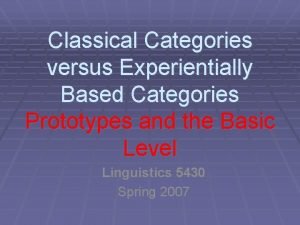CHAPTER FOUR COMPUTER SOFTWARE CHAPTER HIGHLIGHTS Main categories


























- Slides: 26

CHAPTER FOUR COMPUTER SOFTWARE

CHAPTER HIGHLIGHTS • Main categories of software – Operating system – Application – Programming • Functions of the operating system • Types of programming languages • Software for multimedia development 2

SOFTWARE • A collection of computer programs that govern the operation of a computer. – Program: list of instructions that can be carried out by the computer. • Three categories of software: – Operating systems – Programming languages – Applications. 3

YOU DECIDE … Software Label each as an operating system, programming language, application. 1. 2. 3. 4. 5. 6. 7. 8. Word Photoshop Java OS X Visual Basic Flash Windows 8 C+ 9. 10. 11. 12. 13. 14. 15. 16. Linux Open Office HTML Javascript Browser Director Unix Assembly 4

OPERATING SYSTEM • Collection of programs that: – Provides a user interface – Manages computer resources – Executes application programs. • User interface: a means to communicate with the programs and hardware. – Command line interface – Graphical user interface (GUI) – Natural user interface (NUI). 5

OPERATING SYSTEM • Manages computer resources such as: – – Processor Memory Peripheral devices Networks. 6

MANAGE COMPUTER RESOURCES • Manage the processor – Controls how and when programs are executed. – Control methods: • Single user, single tasking • Single user, multi-tasking – If the processor is sufficiently powerful users are not aware of sharing the resources. 7

MANAGE COMPUTER RESOURCES • Manage memory – Controls how much memory is accessed and used by application programs. • Virtual memory: operating system assigns a portion of the hard disk to simulate RAM. – Problem: access to files in virtual memory is slowed. – Solution: install more RAM. 8

MANAGE COMPUTER RESOURCES • Control peripherals – Built-in programs control devices such as monitors, printers, storage drives. – Additional device drivers can be downloaded or come with the installation CD. • Plug and Play – Operating system senses that a new device is plugged into the system board and immediately responds to "play" the device. 9

MANAGE COMPUTER RESOURCES • Manage access and security of network computers through: – – Built in protocols to connect to WANs (TCP/IP) Built in protocols to connect to LANs (Ethernet) Support for Wi. Fi and Bluetooth connectivity Network firewall protection. 10

MANAGE COMPUTER RESOURCES • Utility programs – Tools to optimize operating system functions such as: • • • CD and DVD recording Screen savers Speech recognition for basic commands Text editors Multimedia utilities. – Disk management utility • Partition and format drives. • Defragment and detect disk errors. 11

MANAGE COMPUTER RESOURCES • File management. – Operating systems govern storage and retrieval of files. – Basic file management includes: • • Copy Delete Rename Move. – File extensions identify a file as data or program for the operating system. 12

FILE MANAGEMENT • Directories are storage locations for groups of files. – Directory path is identified by the operating system. – Directories (or folders) are created, moved, copied, deleted using file management utility. 13

PROGRAMMING LANGUAGES SYNTAX AND SEMANTICS TO WRITE COMPUTER PROGRAMS. 14

PROGRAMMING LANGUAGES • Low-Level Languages. – Programs are written for a specific computer system. – Machine code — binary code the processor directly executes. – Assembly code — text abbreviations for binary commands. • Requires a program (assembler) to convert the abbreviations to binary code. 15

PROGRAMMING LANGUAGES • High-Level Languages. – Syntax and semantics are not dependent on a specific computer system. – More English-like commands. – Easier to debug errors. • Two methods to convert to machine code: – Interpreter converts and executes one line of code at a time. – Compiler converts entire program to an executable file. 16

Approaches to Programming • Procedural approach: – Follows a series of computational steps that focus on a specific result. • Divides complex tasks into subroutines, functions that can be reused within a single program environment. • Code modules cannot be ported to other applications without significant modification which leads to inefficiency in programming tasks. • Non-procedural: – Maximizes programmer productivity by recycling modules from one program into other applications. 17

Two Non-procedural options • Object-Oriented languages. – Modular approach reduces time to recode similar object routines. • Visual programming. – Use graphical interface to expedite programming process. – Enables Rapid Application Development. 18

APPLICATION SOFTWARE THAT PERFORMS A SPECIFIC TASK. 19

APPLICATION SOFTWARE • Two main categories for multimedia development. – Media-specific applications. • Create and edit specific media content. – Authoring applications. • Tools to integrate media components and provide a user interface. 20

MEDIA-SPECIFIC APPLICATIONS • Text media applications include: – Word processors – Text editors – Portable document generators. • Graphics media applications include: – Paint programs – Draw programs – 3 -D imaging applications. 21

MEDIA-SPECIFIC APPLICATIONS • Sound media. – Sound capture applications. – Synthesized sound applications. • Video applications combine: – – Source material Synchronize clips to sound track Add special effects Save as a digital video. 22

MEDIA-SPECIFIC APPLICATIONS • Animation applications. – Software to create and edit animated sequences. – Objects are drawn or imported into the software where they are manipulated in a series of frames. • Media utilities. – Add functionality to media-specific applications such as file compression and file conversion. 23

AUTHORING SOFTWARE • Programs designed to facilitate the creation of multimedia products. – – Assemble media elements Synchronize content Design user interface Provide user interactivity. • Authoring metaphors are: – Card based – Timeline – Icon. Power. Point uses a card metaphor. Flash uses a timeline metaphor. Authorware uses a icon metaphor. 24

WRAP UP • • • Three software categories. Functions of operating system. Disk and file management practices. Levels of programming languages. Application software for multimedia. – Media-specific software. – Authoring software. 25

KEY TERM CHECK UP 26
 What are the main software categories?
What are the main software categories? Software categories
Software categories Main categories of software
Main categories of software Computer software is divided into two categories
Computer software is divided into two categories Key highlights icons
Key highlights icons Proposal highlights
Proposal highlights Highlights memorandum
Highlights memorandum Investment highlights
Investment highlights Highlights from the book of isaiah
Highlights from the book of isaiah Highlights from the book of isaiah
Highlights from the book of isaiah Conflict resolution work immersion
Conflict resolution work immersion The passage highlights……
The passage highlights…… Principles of art
Principles of art Standing water ecosystem
Standing water ecosystem What are the four noncompeting categories of labor
What are the four noncompeting categories of labor Print making types
Print making types Body tissue
Body tissue Introduction of service marketing
Introduction of service marketing Difference between will and going to future
Difference between will and going to future Finding the main idea why were canals built?
Finding the main idea why were canals built? Void main int main
Void main int main Four main groups of plants
Four main groups of plants Four main groups of plants
Four main groups of plants What are the four main attributes of professional image
What are the four main attributes of professional image Four main components for effective outlines
Four main components for effective outlines Definition technical communication
Definition technical communication Icon based authoring tools example
Icon based authoring tools example
